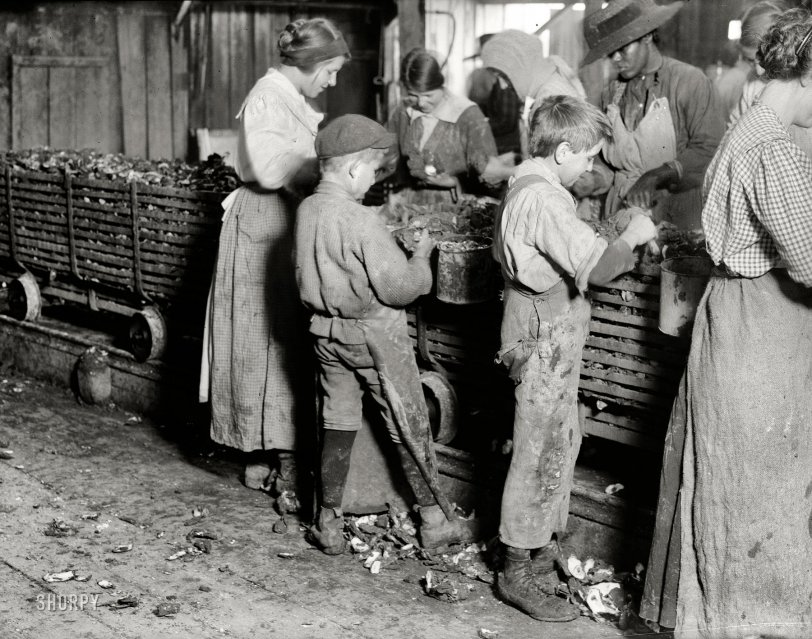


Framed or unframed, desk size to sofa size, printed by us in Arizona and Alabama since 2007. Explore now.
Shorpy is funded by you. Patreon contributors get an ad-free experience.
Learn more.

- Lofty addition
- In 1912
- Keenan Building
- Six years old
- Taken from the P.J. McArdle Roadway?
- It stood only 47 years
- Three track mind
- Incline to the right
- Reach for the sky, 1912 style
- No clean sweep
- Same Job Title, Same Face
- Sadly Lost
- Beautiful ...
- Where you get your kicks
- Aim High
- Pueblo Revival sisters
- Pueblo Neoclassicism
- Milk Man
- Regional dialect.
- Spielberg's inspiration
- Great Photo
- Loaf Story
- Do you still have the Rakes category?
- Could almost be a scene from the 1957 movie 'Hell Drivers'
- The Wages of Fear.
- Conspicuous by their absence
- Got Milk?
- All that aluminum
- No lefties
- Smoke 'em if you've got 'em
Print Emporium
Oyster Express: 1913

February 1913. Bluffton, South Carolina. "Varn & Platt Canning Co. 10-year-old Jimmie. Been shucking 3 years. 6 pots a day, and a 11-year-old boy who shucks 7 pots. Also several members of an interesting family named Sherrica. Seven of them are in this factory. The father, mother, four girls shuck and pack. Older brother steams. 10 year old boy goes to school. Been in the oyster business 5 years. Father worked for 25 years in the Pennsylvania Coal Mine, and the oldest brother there. They said they liked the oysters business better because the family makes more." Photo and caption by Lewis Wickes Hine. View full size.
We Still Like 'Em
Oysters are still greatly savored in the Lowcountry of South Carolina. In the months without an "R," when the pesky mosquitoes and equally vile and ravenous no-see-ums have died down, friends and families gather for oyster roasts, where oysters are steamed and consumed by the bushel. Some can only eat them doused in hot sauce, but the purists will crack the shells and swallow them right down - sometimes raw. For those who don't care for oysters, there's plenty of local fresh shrimp, flounder, and the like to fill up on.
For those who live on the waterways, they can literally harvest the oysters right out of their own back yard.
Kudos to SC Game and Wildlife, as they are making significant strides in recreating oyster beds by returning empty shells to the water.
And huge, too
We think of oysters as being relatively small, the shells being, generally, the size of your palm or smaller. In past centuries, when oysters were harvested from natural beds they were often a foot long and more. These days, they are grown in oyster farms, and so smaller.
I lived on City Island, originally the home of the "oyster catchers" in the New York City area. The livelihood died when pollution made eating oysters in the area unsafe to eat.
Didja ever?
When I was young and popular, I would often receive gourmet gift packages for certain occasions. One constant staple therein was canned smoked oysters. At first I did not think they were going to be wonderful, but if you try one, they grow on you and become addictive tasty morsels. (He likes it, Mikey likes it.) Actually shucking oysters on the other hand (no pun intended) is painful work, as it is common to seriously gouge your palms with the oyster knife due to the very hard, tightly closed shell. No job for sissies.
Today's gourmet item was yesterday's PB&J
The comment by "tterrace" illustrates how things change when an item becomes scarce. What was formerly a common food item has now become a gourmet treat.
Reminds me of the Mercedes-Benz automobiles. Kept scarce, and sold as luxury cars in the States, you can find the sedans working as taxicabs in Europe and the Middle East. I remember seeing photos of war-torn Beirut with Mercedes taxis all over the streets - perhaps our webmaster can find a photo to prove this!
Re: Oysters Have That Reputation
That's what I heard, too, in my younger days, so I tried a dozen. I was disappointed when only seven of them worked.
Why oysters?
Oysters were a cheap and plentiful food for the working class from the 19th through the early 20th century, when the extensive beds began to be destroyed by pollution, sedimentation and other factors. See the "Human History" section in the Wikipedia oyster article.
What did they do with all those oysters, anyway?
"Shucking oysters" is a frequent theme with Lewis Hine.
But what did they do with them in the first place? Can them? Must have gone out of fashion. I have only met fresh ones. And the lesser mollusks available in cans or glasses I leave be.
Our daily bread
Imagine the drudgery of working this line to earn a living. What a choice for the family to make: work in the coals mines of Pennsylvania, or a cannery in South Carolina. How many families make such an effort today? We generally go our separate ways during the workday. Notice the integrated workforce in the days of the Jim Crow South.
The boys were of my grandparents' generation. Probably had little schooling and lots of backbreaking work during their childhood. The good old days?
Today, the area just east of Bluffton is comprised of luxury homes and golf courses: Hilton Head. I doubt any of these folks could have imagined such a lifestyle.
Oysters Have That Reputation
Good sized family, those Sherricas.
























On Shorpy:
Today’s Top 5